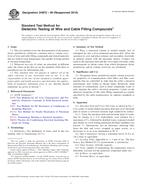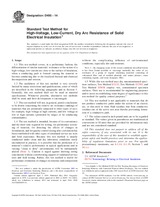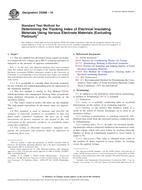Potrebujeme váš súhlas na využitie jednotlivých dát, aby sa vám okrem iného mohli ukazovať informácie týkajúce sa vašich záujmov. Súhlas udelíte kliknutím na tlačidlo „OK“.
ASTM D2303-13
Standard Test Methods for Liquid-Contaminant, Inclined-Plane Tracking and Erosion of Insulating Materials
Automaticky preložený názov:
Štandardné skúšobné metódy pre Liquid-Znečisťovanie, šikmé-Plane Sledovanie a erózie izolačných materiálov
NORMA vydaná dňa 1.4.2013
Informácie o norme:
Označenie normy: ASTM D2303-13
Poznámka: NEPLATNÁ
Dátum vydania normy: 1.4.2013
Kód tovaru: NS-19972
Počet strán: 11
Približná hmotnosť: 33 g (0.07 libier)
Krajina: Americká technická norma
Kategória: Technické normy ASTM
Kategórie - podobné normy:
Anotácia textu normy ASTM D2303-13 :
Keywords:
electrical, erosion, erosion resistance, inclined-plane, liquid contaminant, surface arcing, surface tracking, time-to-track method, track, tracking, tracking resistance, tracking voltage, voltage method, wet tracking, ICS Number Code 29.035.01 (Insulating materials in general)
Doplňujúce informácie
| Significance and Use | ||||||||||
|
4.1 These test methods differentiate among solid electrical insulating materials on the basis of their resistance to the action of voltage stresses along the surface of the solid when wet with an ionizable, electrically conductive liquid contaminant. 4.2 These test methods quantitatively evaluate, in a relative manner, the effects upon an insulating material resulting from the action of electrical discharges upon a material surface. The effects are similar to those that may occur in service under the influence of dirt combined with moisture condensed from the atmosphere. 4.2.1 In the field, the conditions resulting in electrical discharges occur sporadically. Degradation, often in the form of a conducting “track,” develops very slowly until it ultimately bridges the space between conductors thus causing complete electrical breakdown. 4.2.2 In these test methods, the conducting liquid contaminant is continuously supplied at an optimum rate to the surface of a test specimen in such a fashion that essentially continuous electrical discharge can be maintained. 4.2.3 By producing continuous surface discharge with controlled energy it is possible, within a few hours, to cause specimen failure which is similar to failure occurring under long-time exposure to the erratic conditions of service in the field. 4.2.4 The test conditions, which are standardized and accelerated, do not reproduce all of the conditions encountered in service. Use caution when making either direct or comparative service behavior inferences derived from the results of tracking tests. 4.3 The time-to-track a 1-in. (25-mm) distance at a specified voltage between electrodes separated 2 in. (50 mm) has also been found useful in categorizing insulating materials for indoor and protected outdoor applications, such as metal-clad switchgear. 4.4 The initial tracking voltage has been found useful for evaluating insulating materials to be used at high voltages or outdoors and unprotected, as well as for establishing (see 4.5 In service many types of contamination cause tracking and erosion of different materials to different degrees. This method recognizes the importance of such variability and suggests the use of special test solutions to meet specific service needs. For example, an ionic contaminant containing, in addition, a carbonaceous component such as sugar is substituted to cause tracking on very resistant materials like polymethylmethacrylate. Such contamination is considered representative of some severe industrial environments. In this case, the time-to-track technique is used, since time is required to decompose the contaminant solution and build up conducting residues on the sample surface. 4.6 Very track-resistant materials, such as polymethylmethacrylate, typically erodes rather than track under more usual contaminant conditions in service. The use of this method for measuring erosion is consequently important. For erosion studies, only tests as a function of time at constant voltage are useful. |
||||||||||
| 1. Scope | ||||||||||
|
1.1 These test methods cover the evaluation of the relative tracking and erosion resistance of insulating solids using the liquid-contaminant, inclined-plane test.1.2 Two tracking and one erosion test procedure are described: 1.2.1 A “variable voltage method” to evaluate resistance to tracking. 1.2.2 A “time-to-track method” to evaluate resistance to tracking. 1.2.3 A method for quantitative determination of erosion (1.3 While a particular contaminant solution is specified, other concentrations of the same contaminant, or different contaminants are used to simulate different environmental or service conditions. 1.4 The values stated in inch-pound units are to be regarded as the standard. 1.5 This standard does not
purport to address all of the safety concerns, if any, associated
with its use. It is the responsibility of the user of this standard
to establish appropriate safety and health practices and determine
the applicability of regulatory limitations prior to use.
Standard Test Method for Dust-and-Fog
Tracking and Erosion Resistance of Electrical Insulating
Materials Standard Terminology Relating to
Electrical Insulation Standard Test Method for Comparative
Tracking Index of Electrical Insulating Materials (Includes all
amendments and changes 2/2/2022). IEC 60587 Test Methods for Evaluating Resistance to
Tracking and Erosion for Electrical Insulating Materials Used Under
Severe Ambient Conditions Standard Test Methods for Thickness of
Solid Electrical Insulation |
Podobné normy:
Historická
1.5.2010
Historická
15.5.2014
Historická
1.2.2013
Historická
1.3.2010
Historická
1.4.2014
Historická
15.1.2010
Odporúčame:
Aktualizácia technických noriem
Chcete mať istotu, že používate len platné technické normy?
Ponúkame Vám riešenie, ktoré Vám zaistí mesačný prehľad o aktuálnosti noriem, ktoré používate.
Chcete vedieť viac informácií ? Pozrite sa na túto stránku.



 ASTM D4565-10
ASTM D4565-10 ASTM D4566-14
ASTM D4566-14 ASTM D470-13
ASTM D470-13 ASTM D4872-99(2010)..
ASTM D4872-99(2010).. ASTM D495-14
ASTM D495-14 ASTM D5288-10
ASTM D5288-10
 Cookies
Cookies
